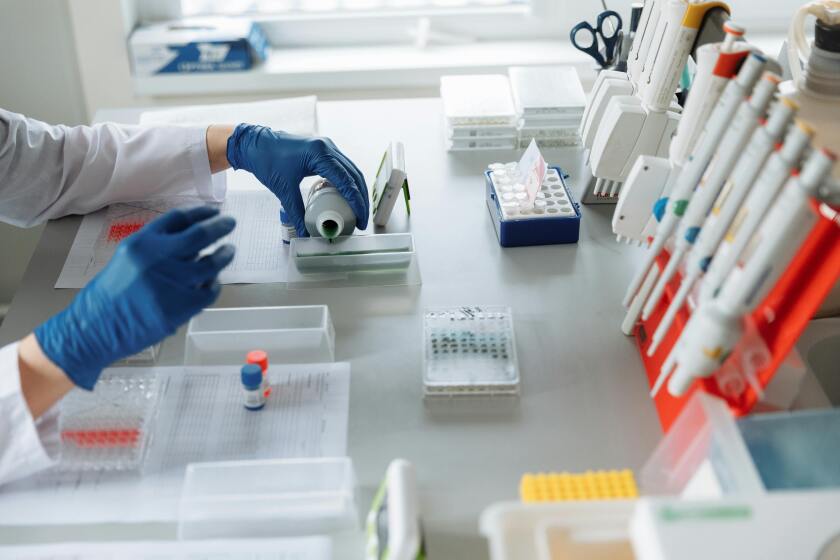In April 2024, China’s Supreme People's Court (SPC), acting as court of appeal, sided with the Beijing Intellectual Property Court (BIPC) in affirming the inventiveness of an enzalutamide compound patent. The SPC overturned an invalidation decision made by the CNIPA on November 5 2018, backing the invalidation action initiated by a Chinese rival, Shanghai Fosun Shinotech Pharmaceutical Co., Ltd., in 2018.
In another invalidation proceeding brought by a different petitioner against the same patent, the CNIPA unsurprisingly declared the enzalutamide compound patent invalid in its entirety on January 4 2019. The decision was revoked by the BIPC on December 29 2021.
So far, the two CNIPA decisions negating the validity of the enzalutamide compound patent have been repealed by effective judgments.
In the appeal proceeding, the SPC found that:
The structure of the enzalutamide compound was non-obvious;
The supplementary experimental data submitted by the patentee in the administrative litigation procedure was admissible; and
The supplementary experimental data sufficed to prove that enzalutamide has an unexpected technical effect, compared with prior compounds.
This case appears to be the first pharmaceutical patent invalidity administrative proceeding wherein supplementary experimental data has been accepted and used to confirm the technical effect of the compound at issue, which is of empirical significance.
Background
The patent at issue is related to an enzalutamide compound (the chemical formula is shown below) titled "Diarylhydantoin compounds". It is RD162' in the patent at issue.
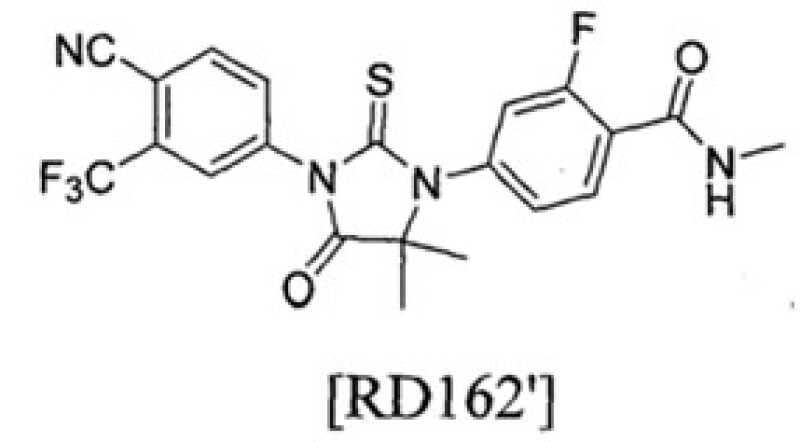
Enzalutamide was jointly developed by San Franciso-based Medivation, Inc. (which is now a part of Pfizer, Inc.) and Japanese-based Astellas Pharma Inc. as an oral therapy for men with metastatic castration-resistant prostate cancer that has spread to other organs or recurred.
Approved by the US Food and Drug Administration on August 31 2012, the drug (trade name Xtandi) received marketing approval in China on November 18 2019. On July 2 2024, Astellas announced that the China Food and Drug Administration had approved enzalutamide for the treatment of metastatic hormone-sensitive prostate cancer. Enzalutamide is a new endocrine therapy solely approved to treat every stage of advanced prostate cancer in China.
The aforesaid CNIPA proceedings marked the failed attempts made by local rivals prior to the patentee’s obtaining of marketing approval for the original drug Xtandi in China.
CNIPA decisions
The two CNIPA decisions both referred to compounds 31 and 41 disclosed in Patent Cooperation Treaty (PCT) application WO2006/028226A1 as the closest prior art, the structures of which, and that of enzalutamide, are shown below.
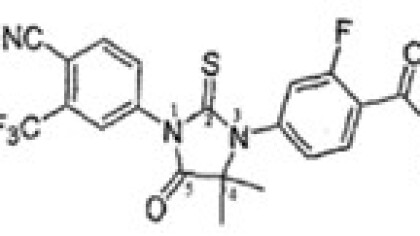
Enzalutamide
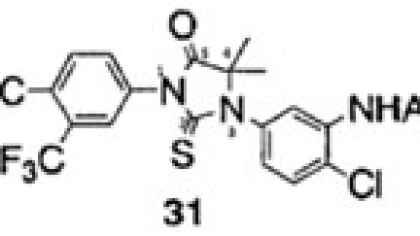
Compound 31
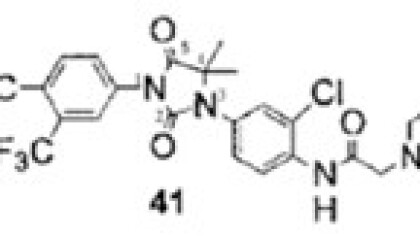
Compound 41
In terms of the technical effect and technical problem actually solved, the decisions opined that the patent at issue only records the in vitro activity data of enzalutamide in contradictory figures 21A and 21B, and that the patent fails to provide experimental data to prove the activity of enzalutamide is superior to that of compounds 31 and 41. Thus, the decisions concluded that the technical problem actually solved was the mere offering of another alternative compound with the same activity to treat prostate cancer.
As to the technical motivation, the decisions found that compound 31, compound 41, and enzalutamide share a connected three-ringed structure of benzene–imidazole–benzene, which falls within the scope of the Markush general formula defined in US5411981 or CN1049214C. And it could be inferred that the connected three-ringed structure, as a common main structure, could have little bearing on the activity effect. Besides, based on bioisosterism and group inversion in drug development, there is a motivation to replace the substituent groups in compounds 31 and 41 to obtain the structure of enzalutamide.
The CNIPA therefore found that enzalutamide did not possess inventiveness when compared with compounds 31 and 41, and declared the patent invalid in its entirety.
BIPC decision
In the administrative litigation procedure, the patentee filed a third-party experiment report on an in vivo anti-tumour efficacy study of enzalutamide, compound 31, compound 41, and bicalutamide as a control compound in lymph node carcinoma of the prostate/androgen receptor (AR) prostate cancer cell animal transplant tumour models. The experimental model in the report is essentially identical to that recorded in the description of the patent at issue.
As regards the supplementary experimental data, the court held that only the antagonistic effect is described in figures 21A and 21B of the description, which does not necessarily correspond to the data over change of tumour size in the animal experiments from the supplementary experimental data. Therefore, the supplementary experimental data could not prove that enzalutamide had a better antagonistic effect, yet lower agonism AR activity, than compounds 31 and 41.
With regard to the non-obviousness of the enzalutamide structure, the court held that, based on the prior art, those skilled in the art would not necessarily choose the corresponding site for the specific substituent replacement with the groups defined in the distinguishing technical features. The petitioner neither justified nor submitted relevant evidence over the replacement sites and groups in the AR ligand field involved.
For bioisosteres, the relativity of regularity dictates that it cannot be assumed as universally applicable in various drug development fields. Instead, detailed explanations for the motivation of the specific substituent replacement, based on parameters such as the sensitivity of structure-activity relationships in pertinent drug fields, is still indispensable. Thus, it would be erroneous to assume that US5411981 or CN1049214C provides the teaching for the specific substituent replacement just because enzalutamide and compounds 31 and 41 fall into the scope of a Markush formula.
The court also underscored that for granted compound patents, especially those being incorporated in corresponding marketed drugs, the complexity of the drug marketing process per se has already verified, to a certain extent, the technical effects of the patents. Under such circumstances, if the petitioner still insists that the compound patent at issue should be declared invalid, it shall bear greater burden of proof so that the inventive labour of the patentee is not at risk of being underestimated.
Given the above, the court held that the petitioner failed to provide sufficient grounds and evidence to show that those skilled in the art could obtain enzalutamide without inventive labour, and thus enzalutamide possesses inventiveness when compared with the prior art.
SPC decision
The SPC upheld the BIPC decision based on somewhat different findings.
The SPC underlined that the admissibility of supplementary experimental data is premised on the following:
The original patent filing documents should clearly describe, or implicitly disclose, the facts to be proven straightforwardly by the supplementary experimental data; and
The inherent defects in the original patent filing documents cannot be remedied by supplementary experimental data.
The SPC went on to analyse the matter from the following aspects:
The description has clearly stated a purpose of "providing a new compound for treating hormone refractory prostate cancer (HRPC)". It also includes the statements "class 1 compounds (Table 5) are superior to bicalutamide in terms of their efficacy in treating prostate cancer" and "class 1 compounds are particularly advantageous as AR antagonists and therapeutic agents in treating hormone refractory prostate cancer". Enzalutamide falls under the category of class 1 compounds.
The experimental objective of figures 21A and 21B is to substantiate the effectiveness of enzalutamide through exhibiting its dose-dependent inhibitory activity at low concentrations. Based on the overall description of the patent at issue, enzalutamide has shown higher antagonistic, yet lower agonistic, AR activity compared with the control bicalutamide. As for the alleged data contradiction in figures 2A and 2B, the court found legitimacy in the patentee’s ascribing of the differences in strength to the two sets of experiments using different batches of cells being conducted on different dates. Therefore, those skilled in the art could understand that enzalutamide, as a class 1 compound, is a particularly advantageous therapeutic agent for treating HRPC when compared with bicalutamide. The technical effect has been documented in the description of the patent at issue.
Regarding the purpose of proof for the supplementary experimental data, the patent applicant, at the time of drafting the original patent filing documents, cannot have expected that compound 31 or 41 would be referred to as the closest prior art in a future invalidation procedure. It is therefore reasonable for the patentee to file the supplementary experimental data generated from the very experimental method documented in the patent to demonstrate the technical effect of enzalutamide disclosed in the description and its superiority to that of compound 41 as the closest prior art, thus corroborating the affirmative conclusion over inventiveness of the recorded technical solution. In light of the excellent technical effect of enzalutamide disclosed in the description, the submission of supplementary experimental data, which is not intended to remedy inherent defects in original patent filing documents, should be admitted.
The supplementary experimental data is closely associated with the technical effect disclosed in the patent at issue. The in vitro experiments and the in vivo experiments of the patent are highly correlated. In vitro experiments are conducted to observe the inhibitory effect in cell petri dishes, while in vivo experiments are conducted to observe the same inhibitory effect in real animal models. However, both experimental results stem from the strong inhibitory effect of the compound enzalutamide on HRPC.
Based on the above reasoning, the SPC ascertained that those skilled in the art could confirm the technical effect of enzalutamide as a class 1 compound, based on the description of the patent and other disclosed data. Besides, the supplementary experimental data demonstrates that in the same animal model as described in the patent, enzalutamide shows superior technical effects to those of compound 41. Thus, the SPC boiled down the technical problem to be actually solved by the patent relative to the closest prior art, in providing a compound with higher antagonistic, yet lower agonistic, AR activity effects.
In assessing the structural non-obviousness of enzalutamide, the SPC reaffirmed the lower court’s findings on bioisosteres. It also acknowledged that the sensitive structure-activity relationships of the patented compounds mean that seemingly minor changes in the structures of compounds may lead to seismic changes in the properties of the compounds used in the treatment of prostate cancer. Therefore, those skilled in the art would be unlikely to predict the activity of the compounds.
The SPC concluded that those skilled in the art would have no reasonable expectation of success in solving the above technical problem by combining US5411981 and common knowledge based on prior PCT application WO2006/028226A1 to obtain the patented compound. The court therefore found that the enzalutamide compound possesses inventiveness when compared with the prior art.
Final comments
The admissibility of supplementary experimental data has been hotly debated in the examination of pharmaceutical patents.
In 2020, the SPC introduced in the Provisions on Several Issues Concerning the Trial of Administrative Cases Involving the Granting and Confirmation of Patent Rights (I) an Article 11, which allows the applicant or patentee of a drug patent to submit experimental data after the date of application for the purpose of further proving full disclosure or a technical effect different from that in the reference documents.
Later that year, the SPC used AstraZeneca v Salubris (2019, Zui Gao Fa Zhi Xing Zhong No. 33) to further elaborate on the metrics employed in assessing the admissibility of such data. The assessment is bifurcated: the original patent filing documents should clearly describe or implicitly disclose the facts to be proved by the supplementary experimental data, and they should be free of any inherent defects to be remedied by supplementary experimental data.
In this case, the SPC delves into the parameters to be factored in when assessing the fulfilment of the aforesaid prerequisites.
In assessing the explicit inclusion or implicit disclosure of the facts to be proved, the overall content of the description shall be scrutinised – including conclusive descriptions, the statement of experimental methods, and the overall technical effects – to ascertain whether the technical effect to be proved has been incorporated in the description.
The SPC made it clear that supplementary experimental data used to prove the superiority of the technical effect to that in the reference documents submitted by the patentee, by employing the same experimental methods as the patent, does not constitute a remedying of inherent defects in the original patent filing documents. On top of that, the SPC does not mandate that the experimental methods of supplementary experimental data must be identical to those documented in the patent description. Instead, the court would ascertain the admissibility and weight of the supplementary experimental data based on whether the difference between the methods would have a substantial impact on the accuracy of the results.
The case may serve as a point of reference in creating uniform jurisprudence in respect of the examination of pharmaceutical patents. Applicants could also take heed of the guidance offered by the SPC and further refine their pharmaceutical patent filing strategy.

